September 1, 2023
Air Date: September 1, 2023
FULL SHOW
SEGMENTS
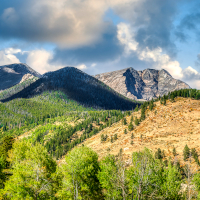
U.S. Primed for Climate Troubles
/ Aynsley O'NeillView the page for this story
Because of its unique geography, the United States is particularly vulnerable to nearly every kind of natural disaster: tornadoes, hurricanes, wildfires, blizzards, and more. And as Associated Press science writer Seth Borenstein explains to Host Aynsley O’Neill, these natural disasters are getting an unnatural boost with climate change. (08:55)
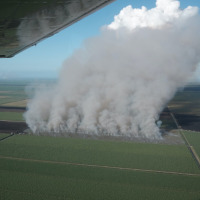
Burning Sugarcane Pollutes Communities of Color
/ Sandy TolanView the page for this story
Some Florida sugarcane growers near the Everglades still use the archaic method of burning fields to remove the tops and leaves before harvesting the sweet cane stalks. As reporter Sandy Tolan explains, communities of color nearby assert they bear a disproportionate burden of adverse health effects from the resulting smoke and ash pollution. (21:31)
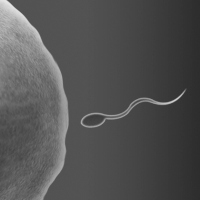
Troubling Trend of Fewer Babies
View the page for this story
Over the past four decades, sperm levels among men in Western countries have dropped by more than 50%, and female fertility is also declining. Chemicals known as hormone disruptors are key culprits, including phthalates found in plastics. Shanna Swan, professor of Environmental Medicine and public health at Mount Sinai School of Medicine, led this groundbreaking research and is the author of the 2021 book, "Countdown: How Our Modern World is Threatening Sperm Counts, Altering Male and Female Reproductive Development and Imperiling the Future of the Human Race". Dr. Swan joins Host Steve Curwood to discuss the growing fertility crisis and why it hits vulnerable communities especially hard. (16:06)
Show Credits and Funders
Show Transcript
230901 Transcript
HOSTS: Steve Curwood, Aynsley O’Neill
GUESTS:
REPORTERS: Sandy Tolan
[THEME]
CURWOOD: From PRX – this is Living On Earth.
[THEME]
CURWOOD: I’m Steve Curwood.
O’NEILL: And I’m Aynsley O’Neill.
The environmental injustice of sugar cane burning.
VOICE 10: The ash, unaffectionately known as the black snow. Ash is just raining down upon everything. Your homes, your clothes, your food... It's like it's almost apocalyptic at times, especially when fields are being burnt simultaneously. You know the smoke can block out, block the sun out... the community actually turns dark. It's like, wow, man, this is this is crazy.
CURWOOD: Also, how phthalates and other chemicals can disrupt reproduction.
SWAN: We did a whole series of studies showing that when a mother had higher levels of those phthalates in her urine the sons were born with genital changes and then we showed that the changes in adults were related to sperm count.
CURWOOD: That and more, this week on Living on Earth – Stick Around!
[NEWSBREAK MUSIC: Boards Of Canada “Zoetrope” from “In A Beautiful Place Out In The Country” (Warp Records 2000)]
[THEME]
U.S. Primed for Climate Troubles
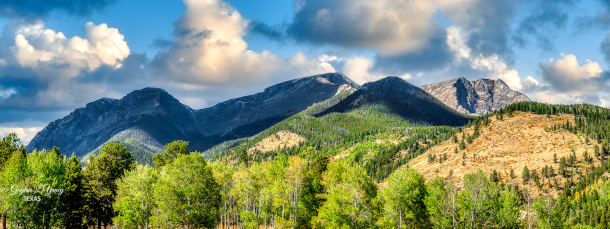
When dry air from the Rocky Mountains combines with moist air from the Gulf of Mexico, severe weather can brew. (Photo: G. Lamar, Flickr, CC BY 2.0)
CURWOOD: From PRX and the Jennifer and Ted Stanley Studios at the University of Massachusetts Boston this is an encore edition of Living on Earth. I’m Steve Curwood.
O’NEILL: And I’m Aynsley O’Neill.
Thanks to our unique geography, the United States is particularly vulnerable to nearly every kind of natural disaster. We have more tornadoes each year than any other country in the world. We are also prone to hurricanes, wildfires, and blizzards. These natural disasters are getting an unnatural boost with climate change and the US can expect to be ground zero for more destruction in the coming decades. For details we’re joined by Seth Borenstein. He’s a science writer with the climate and environment team at the Associated Press.
O'NEILL: So what geographical features make the United States so uniquely susceptible to extreme weather?
BORENSTEIN: Well, you've got two oceans, the Atlantic and the Pacific. And then you have the Gulf of Mexico, which is a third coast. And then you have the Rocky Mountains right through the middle of the United States going north south. The United States is also in the mid latitudes, where you get the difference between the cold in the polar regions, and the hot in the tropics. And then you also have the Jetstream, which comes whizzing through. And it's along that Jetstream that's the instability. On one side of the Jetstream you have cold, and the other side, you have hot. I mean, you just look at the United States, it's almost like there's two weather patterns, one country. West is dry and getting drier and the East is wet and getting wetter. So all of those sort of combine in different ways to cause various weather extremes. I mean, tornadoes, hurricanes, wildfires, blizzards. You get nearly every possible one in the United States. And in many of them like tornadoes, you get it far more than anywhere else.
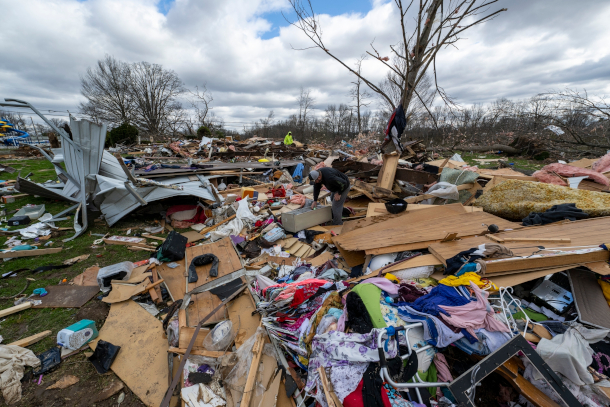
The US is a hotspot for tornadoes worldwide, experiencing around 1200 of these devastating storms each year. (Photo: Dough McSchooler for Associated Press)
O'NEILL: So lots of other countries will certainly have coastlines and huge mountain ranges, you know, the Himalayas or the Andes. And well, in places like Australia, they're just completely surrounded by water. So how do the weather hazards of these other countries compare to those of the United States?
BORENSTEIN: Well, Australia does have some of those issues. But if you think about it, much of these changes also brew in the center. If you have hazards in the Australian Outback, it doesn't affect many people, because there are a few people. The other thing is Australia, it's not quite in the same place where you have sort of the Jetstream plunging through. China's another good one, I kept asking when I talked to scientists in terms of comparisons. But what China has is just the one major coast, and it doesn't get the mixing or clashing of air that the US gets. I mean, it's not to say that there aren't natural hazards anywhere else. It's just we get a wide variety.
O'NEILL: Well, geography handed us a combination of dangerous ingredients. But our choices are also playing a role here. How are we exacerbating the situation?
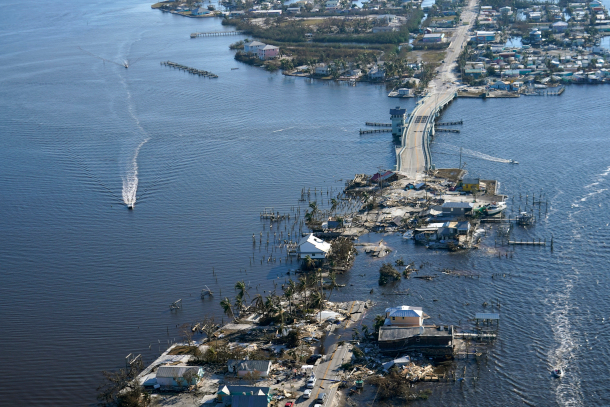
With warming oceans hurricanes are likely to become wetter, and therefore more damaging, as the climate crisis continues. (Photo: Gerald Herbert for Associated Press)
BORENSTEIN: The key here is these are not disasters in themselves. Meteorologists and disaster experts emphasize that all these weather extremes are hazards, but they're not disasters. What makes them disasters is the human factor. If you have a tornado ripping through the Kansas wheat fields, and there's no one there and no buildings, it's not really a big deal. It's not a disaster. It is just nature. But it's when there's people and buildings in the way that it becomes a disaster. And we are putting people in places that are a little more dangerous. Think of all the construction along the US Eastern and Gulf Coast, which are hurricane prone. People build on areas where they have had total losses. And then they get hurricane insurance, federally funded usually. And then they build again in the same place. And some of the scientists said, you know, we don't do building codes as well as we should. For example, in hurricane areas, you can buy hurricane clips, which are like $20 or so, $10 to $20. These are these metal clips you put on your roof beams to help attach and keep your roof during a hurricane. And many places don't require that. It's such a cheap thing. In Tornado Alley, some places cannot build basements, but basements are crucial, or some kind of tornado shelter. A little bit under 50% of deaths they find in tornadoes, are in mobile homes or manufactured houses. If you're going to have mobile homes, maybe mobile home parks should all come with tornado shelters for people to go to. I mean, nature has dealt us a really lousy hand in terms of geography, but then we have made it so much worse.
O'NEILL: Well, the science tells us that climate change will be making storms worse, there'll be making them more common, more intense, but how exactly will they start changing in the case of something like a tornado or a hurricane?
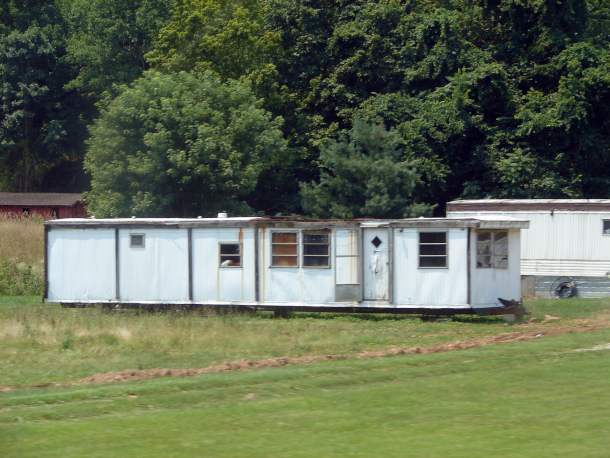
Mobile homes do not have basements, making them more dangerous during severe weather. (Photo: Quinn Dombrowski, Flickr, CC BY-SA 2.0)
BORENSTEIN: So first, tornadoes, it's more of an issue of movement. So in the Great Plains, sort of considered Tornado Alley, computer models show tornadoes decreasing in frequency there but dramatically increasing eastward like Arkansas, Mississippi, Alabama, Tennessee, Kentucky. And scientists have seen these trends starting to happen already. And eastward means more people, more poverty, more density, more trees. So you don't see the tornadoes coming. Like in Kansas or Oklahoma, you see them coming from miles away on, along the prairie. You know, if it's coming through Little Rock, there are trees in the way, you don't see a storm. And the scientists have found when there's tornado warnings, one of the first things people do is they go outside to take a look to see, ooh, is it dangerous looking. And then, and then if it looks dangerous, then they will go in the basement and take shelter. So if you can't see it because of trees and buildings, or if it's nighttime, and in the mid south, we're getting more tornadoes later at night, it's more dangerous. Then with hurricanes, most scientists are now saying more of the stronger hurricanes, and definitely wetter hurricanes. So wetter, slower, makes them more damaging. So it's not quite as easy as things being worse. It's just how they're getting worse.
O'NEILL: Sometimes it feels like those of us who live in the United States are experiencing these extreme weather events, if you'll allow me to use hyperbole, every five minutes. What kind of toll do you think that has on the American people or the American psyche?
BORENSTEIN: I think there's all sorts of possible tolls. But for a while, you say oh my god, this is happening every five minutes. And then after a while, oh, it's just another tornado killing just another 10, 15 people. There's a history in the US public of being shocked that stuff that happens, and then accepting lots of deaths as normal. School shootings. COVID. You know, it's shocking, it's shocking, and then suddenly, it's part of our daily lives. And in many ways, you know, if you think about it, weather disasters have become like that.
O'NEILL: Well, what kind of progress if any, have we made in preparing for these disasters?
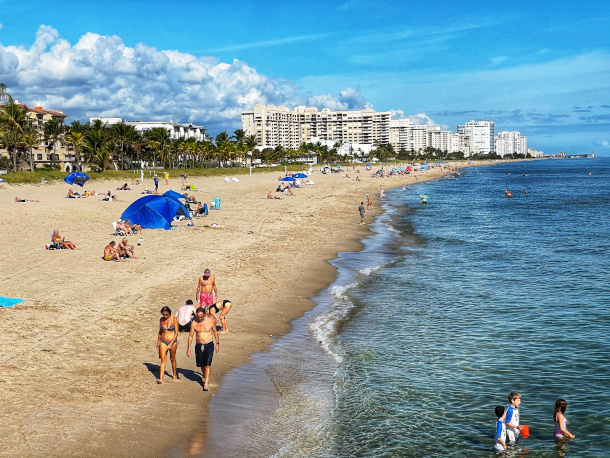
Americans continue to build—and rebuild—along hurricane-prone coastlines. (Photo: Rob Olivera, Flickr, CC BY 2.0)
BORENSTEIN: There are still some good news. For example, lightning deaths the last few years have been at record lows. It's, you know, 10, 12 deaths a year. And in the 50s, and 40s, there were hundreds of deaths a year. And that's because of warning and education. And you know, everyone now knows if there's lightning, get off the golf course, get out of the water. One, people weren't educated in that before. And two, the warnings are so much better. So we're getting so much better about weather forecasts and warnings. The trouble is, there's a disconnect between the warnings out there and how people receive it, and what they do. And also, you know, at some point, there's only so much you can do.
O’NEILL: Seth Borenstein is a science writer with the Climate and Environment Team at the Associated Press.
Related links:
- Associated Press | “The US Leads the World In Weather Catastrophes. Here’s Why”
- NOAA National Severe Storms Laboratory | “Severe Storms 101–Tornadoes”
- The Guardian | “‘Tornado Alley’ Is Shifting Into The US East, Climate Scientists Warn”
[MUSIC: Dr. Michael White, “Give It Up (Gypsy Second Line)” on New Orleans, by Michael G. White, Putumayo World Music]
Join us on September 14th for a Living on Earth Book Club event with author Dorn Cox about regenerative agriculture! Find out more at loe dot org/events.
O’NEILL: If you enjoy the stories you hear on Living on Earth, please consider signing up for our newsletter. You’ll never miss a show, and you’ll have special access to show highlights, notes from our staff, and advanced information about upcoming live events. The Living on Earth newsletter is sent to your inbox weekly. Don’t miss out! Subscribe at the Living on Earth website, loe dot org, That's loe dot org. By the way, you’ll also find photos, links to more information and a full transcript of every single show there. And we’d love to hear from you! You can write to us any time at comments at loe dot org that’s comments at loe dot O-R-G.
[MUSIC: Eric Tingstad, “Long Boats’ on Mississippi, by Eric Tingstad, Cheshire Records]
CURWOOD: Coming up – The fight for clean air in communities of color downwind from the ash and smoke from the sugar cane burning in Florida. That’s just ahead on Living on Earth.
ANNOUNCER: Support for Living on Earth comes from Sailors for the Sea and Oceana. Helping boaters race clean, sail green and protect the seas they love. More information @sailorsforthesea.org.
[CUTAWAY MUSIC: Leo Kottke, “Peg Leg” on Peculiaroso, by Leo Kottke, BMG Music]
Burning Sugarcane Pollutes Communities of Color
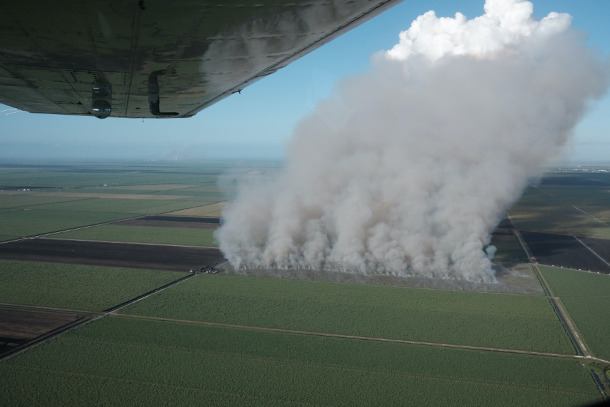
Sugarcane fields are routinely burned to incinerate leaf litter before harvest. (Photo: Courtesy of Jose Jesus Zaragoza)
CURWOOD: It’s Living on Earth, I’m Steve Curwood
O’NEILL: And I’m Aynsley O’Neill.
Sugar cane is a perennial grass that can be harvested as many as five times before being replanted, and for centuries growers would set fields on fire to burn off the tops and leaves before harvesting the sweet canes stalks. Many modern sugar growers use mechanical harvesters to strip away those tops and leaves rather than pollute the air with ash and particulates from burning. But burning persists in Palm Beach County Florida, where with support from the Pulitzer Center, reporter Sandy Tolan found this cheap old-fashioned method is imposing disproportionately high health costs on nearby communities of color.
[PLANE AUDIO SFX]
TOLAN: The single engine Cessna flies low, its shadow flitting along the edge of the Everglades. Decades ago, hundreds of square miles were dug, drained, and scraped, then the rich muck planted in sugarcane.
HARTMAN: So, what we're passing is called the Everglades Agricultural Area.
TOLAN: The Atlantic Ocean sparkles in the east. Just along the shore, the mansions of the sugar barons of Palm Beach.
[TRAFFIC CHATTER SFX]
TOLAN: At a thousand feet, we look down on the source of that wealth: half a million acres of sugarcane. Most of that sea of monoculture belongs to U.S. Sugar, and to Florida Crystals, part of the Fanjul sugar empire.
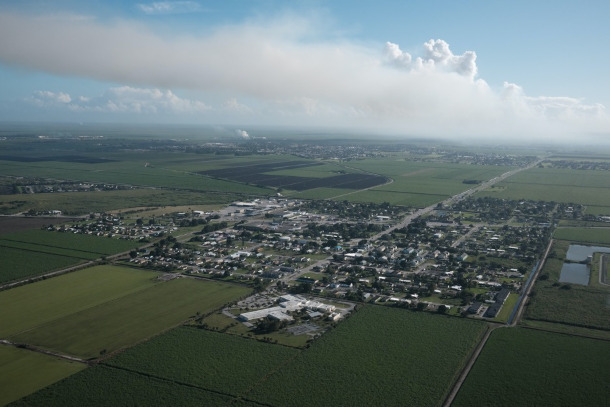
Muck City residents report that ash from sugarcane burns is a constant nuisance and negatively impacts their health. (Photo: Courtesy of Jose Jesus Zaragoza)
[TRAFFIC CHATTER SFX]
TOLAN: Our plane banks to the west. We can see Muck City - the nickname for the largely black towns of Belle Glade, Pahokee, and South Bay. Also known as the Glades.
HARTMAN: I believe that is Belle Glade.
TOLAN: Allie Hartman is with Friends of the Everglades - part of a coalition of environmentalists and local Glades residents fighting the pre-harvest burns.
HARTMAN: Yeah. So, on the left side of the plane here, we're seeing a massive sugarcane burn that starts along that crop line there. And it will continue burning until that entire field has been burned. What it does is it removes what they would call the trash material until only the sugarcane stalk is left. It's a cheaper method for harvest.
TOLAN: Cheaper, and dirtier. How dirty?
[BURNING SFX]
TOLAN: To understand that, I get back on the ground, ride down a washboard cane road, and stop my rental car in front of the flames.
[CAR SFX, BURNING SFX]
TOLAN: It's getting really hot!
TOLAN: From the fire comes smoke; from the smoke: ash. Tons, and tons of ash. The people of Muck City told me about it.
VOICE 2: The ash, unaffectionately known as the black snow. Ash is just raining down upon everything in the community. Your homes, your cars, your food...
VOICE 3: It's like black ash all over the place. It's like raining ash.
VOICE 4: Out of nowhere, you know, you're just sitting there, boom! Ash is on you, you look at your clothes, hey, I got ash on my clothes.
VOICE 5: It messed up our cars and messed up our houses. It messed up our hair. I have natural hair, and when it gets in there, it's really hard to get out.
VOICE 6: Stay inside, keep your windows down or whatever.
VOICE 7: As much as I can try to keep him indoors and say, son, we can't go outside. He's a boy. You know, he wants to run and climb the trees.
VOICE 8: I'm sitting out trying to enjoy a drink. You know, my drink has ash in it and I have to do something about this.
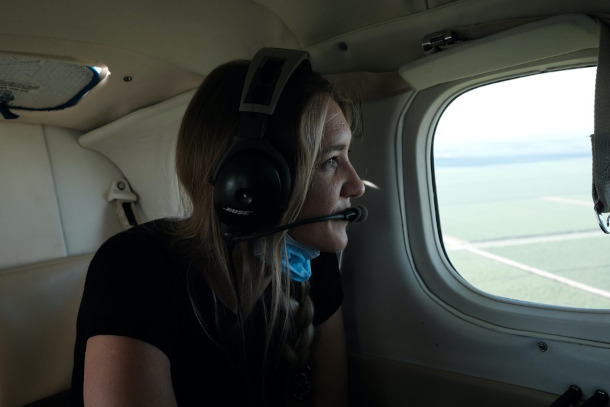
Allie Hartman, Communications Director at Friends of the Everglades, looks out the window at sugarcane fields burning. (Photo: Courtesy of Jose Jesus Zaragoza)
VOICE 9: You would think, like, where is this coming from? Why is it like this?
VOICE 10: It's like it's almost apocalyptic at times, especially when fields are being burnt simultaneously. You know the smoke can block the sun out... the community actually turns dark. It's like, wow, man, this is this is crazy.
TOLAN: It would be crazy just about anywhere else. But the three towns that make up Muck City are company towns. Florida Crystals and U.S. Sugar sponsor little leagues, scholarship programs. They helped pay for a couple of local parks and a community center. But all that comes with a message: don't mess with the burns. Just live with the ash.
PHILLIPS: You know, we felt like, okay, this is just normal. this is what we've been seeing all our life.
TOLAN: This is community activist Kina Phillips of South Bay.
PHILLIPS: You really didn't think like, wow, all these people got asthma like this. Why is this happening? Like, you just don't think about it.
TOLAN: But then Kina Phillips had a grandson.
PHILLIPS: When my grandbaby was born, we noticed that when we take him outside and because it was the burning season, he struggled to breathe. And it got to the point where we had to put him on a machine.
TOLAN: She worked in a hospital and had already started noticing something.
PHILLIPS: Witnessing the increase of people coming in and having to be put on an asthma machine. Or we having to call the ambulance for the kid, to send them to the emergency room because of the shortness of breath and respiratory problems. But when all of these things start happening at one time, you're like, wait, hold on, there's a problem here.
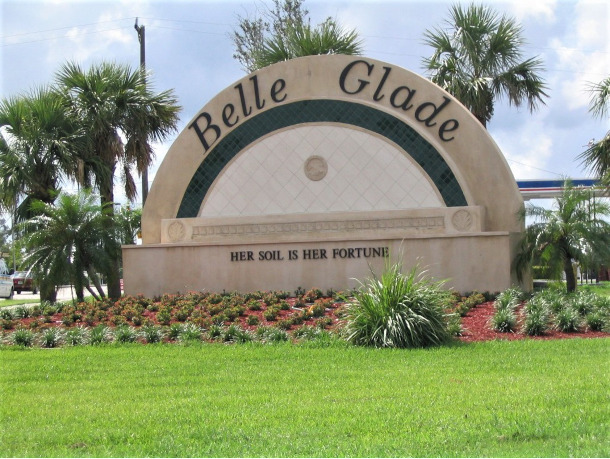
Belle Glade is one of three Florida cities collectively referred to as “Muck City.” (Photo: Blueeagle55, Wikimedia Commons, CC BY-SA 4.0)
TOLAN: So Kina Phillips, working with the former mayor of South Bay, called in the Sierra Club. The Stop the Burn Campaign was born.
PHILLIPS: We came on board and refused to be quiet about it.
TOLAN: Then their colleague Robert Mitchell formed the Muck City chapter of Black Lives Matter. Ms. Phillips says, this is an environmental justice issue.
PHILLIPS: It's racism.
TOLAN: Soon after, they called on Colin Walkes, then the mayor of Pahokee.
WALKES: The Glades welcome my family from the island of Barbados. I migrated here in 1982 with my mom, dad, sister, and brothers.
TOLAN: Colin Walkes sits in a city park in Pahokee, the waves of Lake Okeechobee lapping the shore. He was 10 years old when his family moved to Muck City. After Pahokee High, Colin Walkes moved away for a while. Joined the army. Got his bachelor's in criminal justice. Became a probation officer. And then about 12 years ago, he came back with his own family.
WALKES: One of the reasons I got involved, too: I have a young son that is asthmatic. And since he's been here, he's had about maybe eight or nine asthma attacks. it happens during the Christmas break, you know, during Thanksgiving.
TOLAN: In other words, when the burns were going on. He began to worry about those burns. Then he ran for mayor of Pahokee, and won. He met with Kina Phillips and joined the Stop the Burn campaign.
WALKES: When I was in office, of course, I spoke out against the industry and I don't really call it speaking out. I called it an ask, to basically stop the practice of sugar cane burning.
TOLAN: And adopt safer, cleaner green sugar harvesting, with no burning. In Brazil and Australia, studies indicate green harvesting reduces soil erosion and conserves water. But Mayor Walkes soon realized he, and Kina Phillips, and a handful of other activists, were in a pretty small minority. And that had consequences.
WALKES: Speaking out against our industry as far as the practice of sugar cane burning is kind of like a death sentence here in the community when it comes to your livelihood.
TOLAN: When Colin Walkes ran for re-election, he lost. And then he lost a lot more.
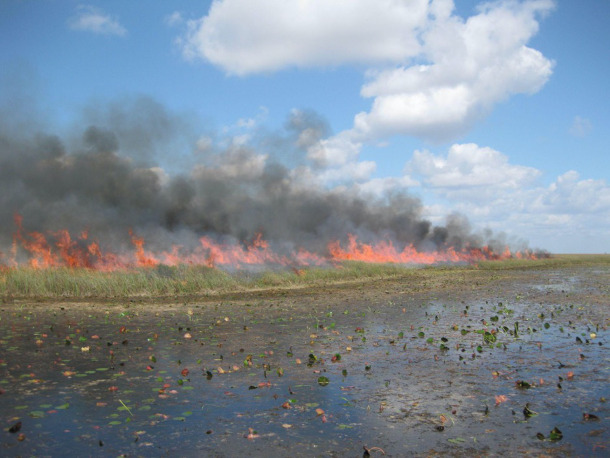
Sugarcane burning near the Florida Everglades. Advocates worry that burning sugarcane poses health hazards. (Photo: Florida Fish and Wildlife, Flickr, CC BY-ND 2.0)
WALKES: The most extreme thing that happened to me was happened in 2021 where I was actually fired from my job.
TOLAN: It was his fulltime job in community engagement, for a local nonprofit. When he engaged citizens on public health and sugarcane burning, he said powerful people complained, and he was out.
WALKES: And it really rocked me. You know, you have a daughter in college, you know, two young sons in the home, a wife. You got a mortgage, car notes and all these type things. I actually lost my home, you know?
[WAVES SFX]
WALKES: You have kids, you know, my boys, oh. "We've got track meets coming up, Dad, or we got this with the band, you know, we got this with robotics." So, it's a tough situation to be in when you have to tell your kid, well, uh, uh, not going to be able to make the meet, not going to be able to make the meet because of basics like gas. You can see the disappointment in your kid's face. "Aw, Dad, man, I thought you was gonna make it to it."
[WAVES SFX]
WALKES: For about a month, we were actually homeless. I actually slept in the park for two nights, here in Pahokee, yeah. We lived in the in the homeless shelter for about a week, a week and a half. You know, my kids were staying with my mom, you know, but we were in the homeless shelter.
TOLAN: The former mayor had to think fast: He put the family savings into a gigantic charcoal smoker and food trailer.
WALKES: This is the firebox…
TOLAN: Now, Coal Brothers Cuisine began showing up at little league and high school football games on the weekends.
WALKES: ...and this is all indirect heating...
[FOOD SIZZLING SFX]
TOLAN: And Colin Walkes kept speaking out against the burns. The campaign wants this year to be the last burn season.
[FOOD SIZZLING SFX]
TOLAN: And so how unsafe are the burns, really? You hear a lot of stories about asthma attacks, more nebulizers in use, strange rashes, even people moving away entirely to get out from under the Black Snow. There's a whole lot of anecdotal evidence of health problems, and not just from the Stop the Burn folks. There's not much official interest in Muck City for in-depth health investigations. Internal studies by the Palm Beach county health department did link cane burning to toxic pollution and potential respiratory and carcinogenic effects. That's according to an investigation by Pro Publica and the Palm Beach Post. Publicly, though, a state official said there was no such proven link. And the many pro-sugar people here say critics are hyping the dangers without enough evidence.
JACKSON MOORE: I'm Tammy Jackson Moore. I've been in the Glades about 30 years, raised my children here.
TOLAN: Ms. Jackson Moore is co-founder of Guardians of the Glades, a community group aligned with the big sugar companies. She says the ash doesn't rain down every day during the burning reason, and when it does --
JACKSON MOORE: I get up and I sweep my porch and I go on about my day. I have never had an asthma attack since I moved here to this community. But I had terrible asthma when I lived in Jacksonville. Do people have asthma in our community? Absolutely. Can we equate their asthma to sugar cane burning? I don't think so. I'm not a doctor. I'm not a scientist. I don't think it's equated. There may be something that helps to trigger their asthma during the during the burning season, but that something could be what's growing here. It could be some of the flowers, it could be anything. But to say that it is because of sugar cane burning, and lay it all on sugar cane burning, I think that's unfair.
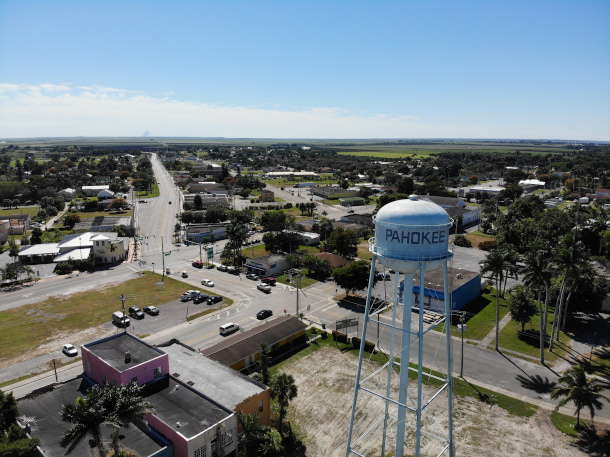
Pahokee Florida is part of what is colloquially known as “Muck City” and is often subject to the impacts of burning sugarcane. (Photo: Yanjipy, Wikimedia Commons, CC BY-SA 4.0)
TOLAN: You may be wondering what Big Sugar is saying. To me? Very little. I called, texted, emailed dozens of times. Finally, someone called back saying: we're not going to meet with you. A PR person for the Fanjuls' Florida Crystals wrote to say that because of previous stories they called unfair and inaccurate, they'd agree to an interview only if it were live on the air and unedited. Which rules out this and just about any other radio program or podcast, so, kind of unrealistic. Florida Crystals did send a statement signed by their vice president. He spent three pages describing their charitable work in education, sponsoring the Muck City Hall of Fame, providing sugar and rice during Covid and other efforts. About the burns, this, read by my colleague:
VOICE 11: Pre-harvest sugarcane prescribed burns are closely regulated and permitted on a daily, field-by-field basis by Florida Forest Service. Before authorizing or denying a permit, the state agency uses state-of-the-art computer modeling with real-time information about atmospheric and meteorological conditions. Air quality monitoring and data show that the area where sugarcane is farmed has some of the best air quality in the State of Florida – better than the state average, year after year.
TOLAN: Just to note: we did edit the company's statement. Reading it out loud, at a normal pace, it took me 13 minutes - almost as long as this entire story. But, what about that air quality claim? Is the air quality around the cane and in Muck City actually better than the rest of Florida? Well...
FERGUSON: To begin with, we know that the amount of particulate matter pollution produced annually by pre harvest sugar field burning during the harvesting season is roughly equivalent to the amount of particulate matter pollution produced by automobile vehicles throughout the state of Florida per year.
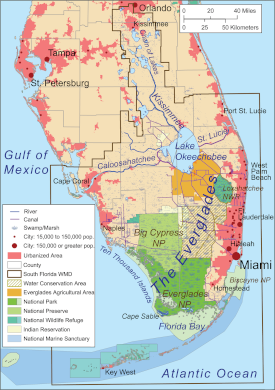
A map of the Everglades. Much of the sugarcane burning activity occurs in the Everglades Agricultural Area, which is highlighted in gold. (Image: Kmusser. Wikimedia Commons, CC BY-SA 3.0)
TOLAN: That's the Sierra Club's Patrick Ferguson, an organizer and attorney who set up shop in a storefront in Belle Glade, to work with Kina Phillips, Colin Walkes and other local campaign leaders. He points to studies in peer-reviewed journals linking cane burning to high concentrations of particulate matter, and to release of carcinogenic chemicals like benzene and formaldehyde. Bottom line, Ferguson says:
FERGUSON: The issue of sugar cane burning is a serious public health problem.
TOLAN: In late 2021 a joint study by Stanford University and NPR found that some of the worst air in the U.S. is in Florida's sugarcane plantations. So, wait: How could the area have both the cleanest air in the state and the worst air in the country? Some say it all comes down to air quality monitors: where they're located, how often they sample, and simply, how many there are.
FERGUSON: The federal air quality monitors that are used to determine compliance with national ambient air quality standards are generally determined by population densities.
TOLAN: And since there just aren't that many people in the Glades: far fewer monitors. So, reporters for ProPublica and the Palm Beach Post set up their own air sensors to register particulate matter, and documented big spikes in pollution during the burns - spikes that the other monitors seemed to miss, says Patrick Ferguson.
FERGUSON: And on days when there were spikes of particulate matter pollution it was when sugar cane burning was blowing in the directions of some of these monitors.
TOLAN: Now. Big Sugar disputes this. The companies accused Pro Publica of "selectively presenting their preferred interpretation" in support of a "biased conclusion,” even suggested they were collaborating with environmental activists - charges the journalists refuted.
NEWS REPORT: A new study raises some troubling concerns about the air quality in western Palm Beach County. CBS 12's Al Pefley says the study looked at the results of sugarcane burning...
TOLAN: But then, late last summer, a peer-reviewed study said particulate matter from the burns contributed to between two and three additional deaths per year across South Florida. It made the evening news.
NEWS REPORTER 2: Researchers from Florida State University looked at information from an atmospheric dispersion model... (dips under)
TOLAN: In the Glades, U.S. Sugar issued a statement.
NEWS REPORTER 3: …saying the FSU study is based on estimates and conjecture, and the statement says, quote, "shame on Florida State University for having its good name associated with such shoddy work."
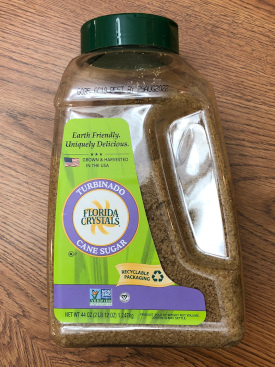
Florida Crystals is one of the sugar companies burning sugarcane in the Everglades area. (Photo: Famartin on Wikimedia Commons, CC BY-SA 4.0)
[BURNING SFX]
TOLAN: But, no matter how good the air really is, no matter how harmful the ash and smoke, there's one question the pro-sugar folks could never seem to answer.
[BURNING SFX]
TOLAN: Why do state officials allow the burns, when the ash falls on communities of color Muck City. And yet, they ban the burns when the wind blows east, toward majority-white communities: the stables and equestrian riding clubs of Wellington, and the Fanjul mansions in Palm Beach?
TOLAN: Sounds hard to believe, right? But documents from a public records request to the Florida Department of Agriculture show: it's a fact. I wanted someone from the sugar industry willing to face my microphone. For a long time, I couldn't find anyone.
REV. REASE: Let us stand and greet everyone, look around...
TOLAN: And then one day, of all places, - in church, I found him.
REV. REASE: God bless you. It's so good to see everyone here this morning
TOLAN: I've come to talk to Rev. Robert Rease, a pro-sugar pastor.
REV. REASE: …Come up and greet the congregation...(dips under)
TOLAN: But, surprise, here in the Lord's house, there's State Rep Rick Roth -- a politician and a sugar grower,
ROTH: Morning, everyone. It's a good day to be in the house of the Lord. Praise God.
TOLAN: He's hawking votes two days before the election…
ROTH: My heart is in the Glades. I've got muck underneath my toes. Thank God I am here today. We need people that fear God to run for public office. Please, I'm asking for your vote...
TOLAN: Now, Rick Roth slips out the back door. And a little rudely, I suppose, so do I.
[DOOR CLICKING, WALKING SFX]
TOLAN: Representative Roth? Representative Roth?...
[WALKING SFX]
TOLAN: He's a bit surprised to see me. But he agrees to talk - and he insists, there's nothing dangerous in the ash.
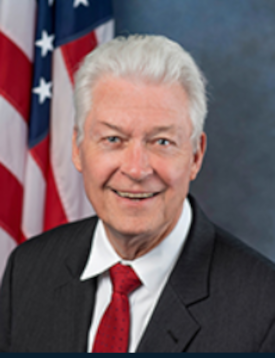
Florida state representative Rick Roth claims that burning sugarcane is safe. (Photo: Florida House of Representatives, MyFloridaHouse.gov, Public Domain)
ROTH: Well, it's funny. We've been doing cane burning ever since the industry really got going in the early 1960s. We have air quality monitoring. We have regulations. Burning is not dangerous to your health unless you're standing out in it and trying to breathe it. It's not an air quality issue. I don’t think it’s a health issue.
TOLAN: I want to ask you one more question…
TOLAN: This burning question: If everything is so safe, why let the Black Snow fall on Muck City, but then, when the wind blows east, toward those wealthier communities, pull the permits?
TOLAN: And a lot of people in Belle Glade feel like that's not fair.
ROTH: The cities had nothing to do with that. This is a Florida regulation.
TOLAN: But what do you think about that? I mean, they’re like…
ROTH: Well, the issue is you always have to make decisions. This is not a hazard. It is obviously an agenda.
TOLAN: But why would why...
ROTH: I’m saying it's an agenda, It's not an issue.
TOLAN: No, but I'm asking you, what about when the wind shifts and they pull the permits?
ROTH: (Pause) The, the regulations are done to do the least amount of harm possible. There is no data, no scientific data, to my knowledge. But you've asked four questions on this issue. Like it's as important as the economy, and it's not.
GOSPEL SINGER: Jesus loves the little children...all the children of the world. Red, yellow, black and white, they're all precious in his sight...
[MARCHING BAND SFX]
TOLAN: In Muck City, right up there with church, is football. This place has produced some 60 NFL players over the years. And no event pulls together the community - sugar boosters and burn critics alike - than the annual Muck Bowl game between Belle Glade and Pahokee high schools. It's Florida's ‘Friday Night Lights’ - and it's where I find Belle Glade Mayor Steve Wilson, just before kickoff.
MAYOR WILSON: We support our industry 100%. We make that clear with everybody.
TOLAN: Mayor Wilson gets pretty annoyed when he talks about the stop the burn campaign.
MAYOR WILSON: I've been here practically all my life. I was born in the city of Belle Glade. I have grandkids here. My kids are here. Do you really believe that I will expose my kids to an environment that's going to really be hazardous, to kill them? I have to be crazy. I love my family more than anything in this world. So all the critics and the naysayers, those folks who always got something to say, you know what? It's a part of life. We move on.
[FOOTBALL GAME SFX]
ANNOUNCER: We do want to make sure we give recognition to Florida Crystal. Let's give it up to all of our large donors…
CHEERLEADERS: BE! AGRESSIVE! B-E A-G-G-R-E-S-S-I-V-E! BE! AGRESSIVE...
[FOOTBALL GAME SFX, CHEERING SFX]
TOLAN: Just before halftime, I find the former mayor of Pahokee, and now-barbecue maestro, Colin Walkes. Today, his alma mater is already ahead by three touchdowns, and the former Pahokee high linebacker is serving up ribs.
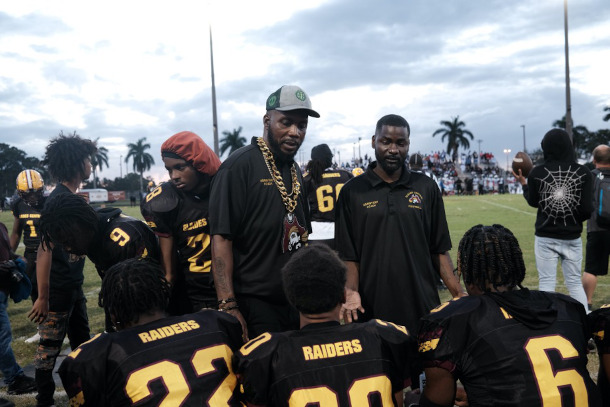
The coach for Glades Central talks to his players. The annual Muck Bowl game between Belle Glade and Pahokee high schools is a beloved community event. (Photo: Courtesy of Jose Jesus Zaragoza)
WALKES: Nothing ever replaces the experience of the mock bowl, you never forget it's like it's constantly playing in your head...you know I can visualize my last mock bowl from 1991. You know, you replay it in your head, all the tackles, all the plays.
TOLAN: Unlike Mayor Wilson, Mayor Walkes took on the sugar companies. After losing two jobs, losing his home, he had to reinvent himself with his Coal Brothers smoked meat.
WALKES: And my love and passion for cooking come from my mom and dad, you know, again, from Barbados, so my food has a kind of Caribbean taste to it
TOLAN: I get chicken on a stick. Tasty and a little bit sweet. Colin Walkes says, it's all good.
WALKES: Never in a million years would I thought I would have been in a situation like that. It cost me a lot. But we're rebuilding and I thank God for his grace and mercy once again, you know, for a sound mind and spirit and soul and a clean heart, you know, that you can rebuild. This is a story of redemption, you know? Yeah. Because I'm happy. Yeah, I'm happy, so...
[CHEERING SFX]
TOLAN: And one thing that would make him even happier: If this year, out on those hundreds of thousands of cane fields, it's the very last season of the burning.
[CHEERING, APPLAUSE SFX]
TOLAN: For Living on Earth, this is Sandy Tolan, in Palm Beach County, Florida.
VOICE 12: That's what we do! That's what we do!
[CHEERING, APPLAUSE SFX FADES]
O’NEILL: Support for Sandy’s story came from the Pulitzer Center for Crisis Reporting.
Related links:
- Watch Friends of the Everglades’ video series The Last Burn Season here
- Click here to read Pro Publica’s work on sugarcane burning in Florida
- See how sugarcane burns color Belle Glade’s landscape on NASA’s Earth Observatory
- Miami Herald | “Florida’s Sugar Harvest Sends Fields Up in Smoke. Some Residents Are Literally Sick of It.”
- Visit Sandy Tolan’s Website
[MUSIC: Habib Koite & Bamada, “Foro Bana” on Ma Ya, by Habib Koite/arr. Habib Koite & Bamada, Putumayo Artists]
CURWOOD: Coming up – A leading expert talks about why we’re faced with a fertility crisis and how we can protect ourselves. Stay tuned to Living on Earth.
ANNOUNCER: Support for Living on Earth comes from Friends of Smeagull the Seagull and Smeagull’s Guide to Wildlife. It’s all about the wildlife right next door to you! That’s Smeagull, S - M - E - A - G - U - L - L, SmeagullGuide.org.
[CUTAWAY MUSIC: Nashville Mandolin Ensemble, “Music for a Found Harmonium” on Plectrasonics, by Simon Jeffes, CMH Records]
Troubling Trend of Fewer Babies
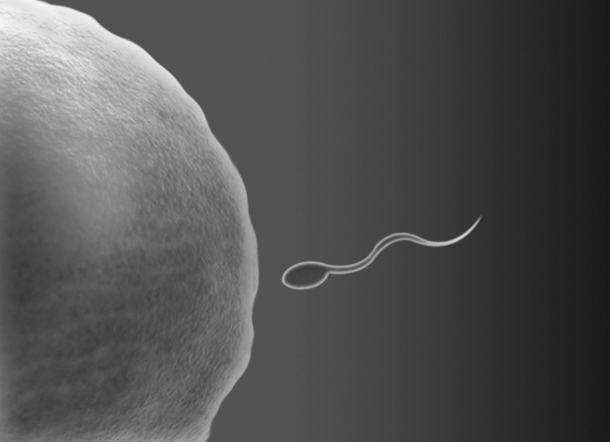
Fertility worldwide has dropped nearly 1% per year from 1960 to 2018. Endocrine disrupting chemicals like PFAS and phthalates play a role in fertility decline by affecting male testosterone, diminishing sperm count, decreasing sperm quality, and increasing erectile dysfunction. (Photo: Zappys Technology Solutions, Flickr, CC BY 2.0)
O’NEILL: It’s Living on Earth, I’m Aynsley O’Neill
CURWOOD: And I’m Steve Curwood.
Phthalates are a common ingredient in plastic and many other products including flooring and non-stick cookware. This class of chemicals can mimic or interfere with hormone systems, and research is linking them to the decline in male fertility, including lower sperm counts and poor quality. Female fertility is also declining. Women today have a harder time conceiving than previous generations. The notion of polluting ourselves into a fertility crisis is exactly the premise of Margaret Atwood’s novel, The Handmaid’s Tale. Made into a tv series, The Handmaid’s Tale is about a dystopian world in which the very few fertile women left are forced to bear children for the ruling class of a religious totalitarian government.
AUNT LYDIA: Fertility is a gift directly from God. He left you intact for a biblical purpose. Like Bina served Rachel. You girls will serve the leaders of the faithful and their barren wives. You will bear children for them. Oh, you are so lucky!
CURWOOD: Shanna Swan is a professor of Environmental Medicine and public health at the Mount Sinai School of Medicine and author of the book Countdown: How Our Modern World is Threatening Sperm Counts, Altering Male and Female Reproductive Development and Imperiling the Future of the Human Race. And she joins me now. Welcome back to Living on Earth Dr. Swan.
SWAN: Thank you, Steve, really happy to be here and talk to you again.
CURWOOD: So let's talk first about the behavioral part about this. What are things that we do to reduce our sperm counts in terms of our diet and habits?
SWAN: Well, some of them are pretty obvious. They're things that we worry about for our heart health and overall health, like smoking. So smoking is very strongly related to sperm count. And what people might not know is that the mother smoking and even the father smoking at the time he conceives the pregnancy can affect the semen quality in the son that was being conceived at that time. So smoking is the big actor. Extreme alcohol, binge drinking is really bad for sperm count. And then diet matters, as do the organic nature of the fruits and vegetables that you're eating. So we showed that when people ate organic fruits and vegetables, the men's sperm count increased. But when the fruits and vegetables were not organic, we didn't see that. Stress is important, the stress of daily life, we found that the number of life events that a man has in his daily life affects his sperm count. And so pretty much everything in our lives that we experience plays a role in our health, and particularly in sperm count.
CURWOOD: And what about the chemicals? What is that doing? What's the relationship between chemicals in this more than 50% decline in the sperm count in the last 40 years?
SWAN: We know something about several classes of chemicals, but we know much less than we should. So I've studied the role of pesticides. So pesticides we've shown are directly related to the sperm count, morphology and motility of sperm. And we showed that in a study where men in rural Missouri, where there's a lot of pesticides had only half as many moving sperm as men in Minneapolis, where there's very low pesticide use. And within that Missouri men, the amount of pesticide in their urine was directly related to their semen quality. So that was a pretty clear picture. We've also seen that phthalates, which are everyday chemicals in our daily lives, make plastic soft and flexible in our personal care products, and so on, that those chemicals, which can lower testosterone, are very important for male reproductive development, particularly when the male is in utero. And we did a whole series of studies showing that when the mother had higher levels of those phthalates in her urine, the sons were born with genital changes, which add up to them being less completely masculinized. And then we showed that those changes in adults were related to sperm count. So we made a link from in utero exposure to adult sperm function. But there are other classes of chemicals that matter, the bisphenols, the Pfoas, and so on. And we are just attacking those because each investigation takes millions of dollars and 10, 15 years. So it's a slow process and this should be cleared up before the chemicals go into the marketplace.

Exposure to endocrine disrupting chemicals during pregnancy can influence the baby’s reproductive system especially during early pregnancy and affect subsequent generations. These toxic chemicals are present in everything from skin care products to food and drinking water. (Photo: Muhirehussein12, Wikimedia Commons, CC BY-SA 4.0)
CURWOOD: Now, let's talk a little bit more about women. You write that women are now less fertile at a young age than their grandmothers once they hit 35. So that means that just within these last couple of generations, two or three generations, the fertility of women has fallen dramatically. What do you think are the main issues women are experiencing when they're trying to have a baby aside from of course, the issue of the quality of semen of sperm that they might be getting for this process?
SWAN: Right? Well, I think the first thing we have to consider and acknowledge is the role of age. So women's fertility and the number of eggs she has available, and the number of good eggs she has available, drops off rapidly once she passes about 32 - 34 years of age. And because couples are choosing for economic and other reasons to delay their first child, this pushing women into this area, this age range in which they're going to have more problems, they're going to have more miscarriage. That said, what the thing you quoted from our book, which is that women in their 20s have less fertility than their grandmothers did in their 30s. That is also going on and that's saying that even young women are having problems and that's not an aging problem. And I wanted to point out that a mother's exposure affects her offspring’s reproductive health and inside that fetus are the germ cells that will produce the next generations children. But the point here is that if we are protecting ourselves, particularly if we're pregnant or for men who are about to conceive a pregnancy, they would be protecting at least three generations. So we have a big responsibility. The good news Steve, which I learned only recently, from Pat Hunt at the University of Washington, she showed that an animal's in the laboratory, you can take a male who's been exposed and has severe reproductive problems, his offspring and his offspring’s, offspring. If there are kept clean, kept unexposed to these chemicals, in three generations, they can recover their reproductive health. And that's kind of encouraging because these chemicals are not persistent most of them the ones we're exposed to today. Some like the PFAS are more persistent, but we're not looking at the old DDT and dioxin and PCBs of which were banned a long time ago, those very long-life chemicals. But phthalates and phenols leave the body in four to six hours. So if we can stop them from coming in, we can clean up our mess.
CURWOOD: Part of the response to the fertility decline and perhaps might be fair to say even we're looking at a fertility crisis, although it seems silent at the moment, is that some folks will use reproductive tech, I'm thinking of in vitro fertilization for one. But you know the cost of that is then five figures, you're talking 10,000 $20,000, perhaps more, and repeat that a few times that becomes a piece of change, or hiring a surrogate to have one's child. So in other words not everyone can afford that, this sounds to me like a case also of environmental injustice, that reproductive rights for poor and underserved communities are affected by the inability to use this technology.

The first trimester of pregnancy is crucial for the reproductive development of the male fetus. Exposure to androgen chemicals can result in a shortening of the anogenital distance (AGD) which can in turn result in a smaller penis and a lower sperm count in adulthood. (Photo: Evan Amos, Wikimedia Commons, Public Domain)
SWAN: That is correct and I wanted to also add that disadvantaged communities we're seeing are actually more affected by these chemicals. I'll give you an example. We have a study in four cities in the United States. One of those studies is Rochester (New York). In Rochester, the Study Center is mostly Medicare, mostly African American, and they are having higher exposures we're seeing and the effect of those exposures, even at the same level are greater than in the other three centers, which are primarily middle class, primarily white, and have lower exposures. So again, three ways in which this is an unjust impact, greater exposure to disadvantaged communities, greater impact of a given exposure, and less opportunity to buy your way out of it, whether it's through assisted reproduction or safer foods, or safer personal care products.
CURWOOD: So what can people do in light of this knowledge? What can people do to lessen their exposure, for example, to endocrine disruptive chemicals that might affect their ability to reproduce?
SWAN: So that's an important question. And it's something that we spend several chapters on in Countdown, our book, this is quite a big story. But I'll try to say a few things that people could do. So first of all I want to preface this by saying the things that people can do may be limited by their economic status. So food access, ability to afford organic foods, ability to afford personal care products that are cleaner and safer. Even having the time to go to the web to look up these products assumes a certain amount of free time and an economic status and an education that not everybody has. So there is an environmental justice issue connected to this question of what can people do and I want to stress that. Okay, so what can people do? Well I recommend that people to the extent they can eat unprocessed food and that's because the processing of food, once it's collected at maybe even an organic farm will introduce chemicals like phthalates and the bisphenols into the food. And we know that because we know that when food goes through plastic tubing, which is soft, it picks up the phthalates from the tubing, enters the food, gets into us, gets into your urine, the CDC can measure it and that's been shown in many settings including for babies in the NICU. So unprocessed food that doesn't go through plastic, isn't packaged in plastic isn't shipped in plastic and certainly is not heated and plastic will be much safer for you. Another thing you can do is try to worry about the things that your home that I like to think of as barriers. So a nonstick pan has a coating on it a Teflon pan has a coating on it right? To keep the food from sticking. That is an endocrine disrupting chemical it's one of the PFAS chemicals. The barriers on our clothing that keep off liquids or rain that's a barrier that isn't that same class of chemicals. Barriers on paper to prevent oil from leaking through, like in a pizza box that will have those chemicals. Then you might ask about the things in our home that are flame retardant. So flame retardant clothing, flame retardant cushions, flame retardant you know, upholstery of various kinds. These are endocrine disrupting chemicals. So basically, I think we have to have a lens that we put on everything we bring into our bodies and into our lives and use that lens to ask what is in it, or what could be in it, try to read labels try to look up information on the web. It's a hard job. And I should say that the consumer should not have to do this. It's not really what we're good at is it? We expect the government to protect us to keep us safe. But they are not doing that as far as these chemicals are concerned.
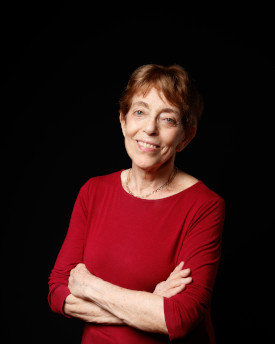
Dr. Shanna Swan is one of the world's leading environmental reproductive epidemiologists and a professor of environmental medicine and public health at the Icahn School of Medicine at Mount Sinai in New York City. An award-winning scientist, her work examines the impact of environmental exposures, including chemicals such as phthalates and Bisphenol A, on men’s and women’s reproductive health and the neurodevelopment of children. (Photo: Alex Dupeux)
CURWOOD: So, you know, around 30 years ago when scientists began sounding the alarm about climate disruption, saying that our activity as humans was dangerously altering the environment people, a lot of people were in denial. And it became an issue between believers in climate change and non believers. And we've been talking about the effects of chemicals that they have on our reproductive health for a long time, as well, without a lot of response from society frankly, up until this point. What relationship in your view is there between climate change and reproductive health?
SWAN: Well, first of all, the analogy you're making, I think, is a really good one, or it's one that I make myself. I see the same story with this sperm decline and fertility decline. It was touted in 1992, originally, that's quite a while ago, getting close to 30 years. And when it first came out, it was not listened to, it was denied. And now with the book, and our tying this all together and identifying environmental causes, and their own experience of infertility in themselves, or in their friends or in their families, they're seeing wow, this is something that we have to pay attention to, we have to do something about this. So but more directly Steve, the tie in between environmental endocrine disruptors, and fossil fuels is very direct, because many of these, if not most of these chemicals are made from fossil fuel byproducts. And in fact, the predictions are that as the use of fossil fuels for driving our cars and heating our homes is going to go down, which is a great thing, there's going to be an increase in the number of plastics on the market, which will make use of those resources which could go anymore into heating our homes and driving our cars.
CURWOOD: You know we're not the only creatures on the planet, right? So what effect Do you think the decline in fertility we're seeing in our species is reflective of what might be going on with animals and insects?
SWAN: I believe that the same chemicals that affect us affect all creatures on the planet, at least those that are responsive to hormone regulation of reproduction. And there was recently a study that showed that dogs, people's pet dogs are affected by the chemicals in their homes and the fertility of those dogs was affected. We see wildlife the effects on alligators and frogs and fish and birds. And there's no end to it. Whenever scientists look for declining species, they can identify these chemicals in the bodies of these animals. And by the way, these endocrine disrupting chemicals are found everywhere. It's not just in busy cities, it's not just in industrialized areas. They’re found at the bottom of the Marianas Trench, and they're found at the Arctic Circle. There's no limit to where these go and so there's no limit to the animals that are affected. So we're all in this together.
CURWOOD: Shanna Swan's book is called Countdown: How our Modern World is Threatening Sperm Counts, Altering Male and Female Reproductive Development and Imperiling the Future of the Human Race. Dr. Swan, thanks so much for taking the time with us today.
SWAN: It's been a pleasure talking to you. Thank you, Steve.
Related links:
- Learn more about Dr. Shanna Swan
- The Guardian | “Most Couples May Have to Use Assisted Reproduction by 2045”
- Scientific American | “Reproductive Problems in Both Men and Women are Rising at an Alarming Rate”
- ALJAZEERA | “Despite Three Child Policy Many in China Can’t Afford More Kids”
[MUSIC: Eric Tingstad, “Tennesse e Rain” on Mississippi, by Eric Tingstad, Cheshire Records]
CURWOOD: Living on Earth is produced by the World Media Foundation. Our crew includes Naomi Arenberg, Paloma Beltran, Josh Croom, Jenni Doering, Swayam Gagneja, Madison Goldberg, Mark Kausch, Mark Seth Lender, Don Lyman, Sarah Mahaney, Sophia Pandelidis, Clare Shanahan, Jake Rego, El Wilson, and Jolanda Omari.
O’NEILL: Tom Tiger engineered our show. Alison Lirish Dean composed our themes. You can hear us anytime at L-O-E dot org, Apple Podcasts and Google Podcasts, and like us, please, on our Facebook page - Living on Earth. We tweet from @livingonearth. And find us on Instagram at livingonearthradio. And you can write to us at comments at loe dot org. I’m Aynsley O’Neill.
CURWOOD: And I’m Steve Curwood, thanks for listening!
ANNOUNCER: Funding for Living on Earth comes from you, our listeners, and from the University of Massachusetts, Boston, in association with its School for the Environment, developing the next generation of environmental leaders. And from the Grantham Foundation for the protection of the environment, supporting strategic communications and collaboration in solving the world’s most pressing environmental problems.
ANNOUNCER 2: PRX.
Living on Earth wants to hear from you!
Living on Earth
62 Calef Highway, Suite 212
Lee, NH 03861
Telephone: 617-287-4121
E-mail: comments@loe.org
Newsletter [Click here]
Donate to Living on Earth!
Living on Earth is an independent media program and relies entirely on contributions from listeners and institutions supporting public service. Please donate now to preserve an independent environmental voice.
NewsletterLiving on Earth offers a weekly delivery of the show's rundown to your mailbox. Sign up for our newsletter today!
 Sailors For The Sea: Be the change you want to sea.
Sailors For The Sea: Be the change you want to sea.
 The Grantham Foundation for the Protection of the Environment: Committed to protecting and improving the health of the global environment.
The Grantham Foundation for the Protection of the Environment: Committed to protecting and improving the health of the global environment.
 Contribute to Living on Earth and receive, as our gift to you, an archival print of one of Mark Seth Lender's extraordinary wildlife photographs. Follow the link to see Mark's current collection of photographs.
Contribute to Living on Earth and receive, as our gift to you, an archival print of one of Mark Seth Lender's extraordinary wildlife photographs. Follow the link to see Mark's current collection of photographs.
 Buy a signed copy of Mark Seth Lender's book Smeagull the Seagull & support Living on Earth
Buy a signed copy of Mark Seth Lender's book Smeagull the Seagull & support Living on Earth

